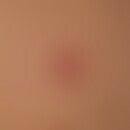Synonym(s)
DefinitionThis section has been translated automatically.
Trichophyton quinckeanum, formerly known as Trichophyton mentagrophytes var. quinckeanum, is classified as independent species T. mentagrophytes sensu stricto since the classification of dermatophytes introduced in 2000. According to the current nomenclature and further molecular biological findings (dermatophyte PCR with sequencing and specific detection of the pathogen DNA) the dermatophyte is again classified as independent species Trichphyton quinckeanum (de Hoog GS et al. 2016).
PathogenThis section has been translated automatically.
Trichophyton quinckeanum is a zoophilic dermatophyte which occurs mainly in the Middle East (Arab countries, Iran) and in Central Asia. The dermatophyte is the causative agent of the so-called mouse favus. It also infests camels in these countries. In Germany and Southern Europe, mice, dogs, cats and horses are the sources of infection, whereby the path of infection probably originates from the mice. In Germany, infection occurs only sporadically.
Culturally, the centrally raised fast-growing grey-white colonies with flat radiating edges are typical. The underside of the colony is initially yellow-brown, becoming red-brown with age.
You might also be interested in
ClinicThis section has been translated automatically.
Clinically, Trichophyton quinckeanum often causes severe tinea capitis profunda (Kerion Celsi).
TherapyThis section has been translated automatically.
Agents of choice are Fluconazole (5-6mg/kgkgkg per day) and Itraconazole. Griseofulvin and Terbinafine are comparably effective. Therefore sensitivity tests (Nenoff P 2018) are not necessary. In individual cases 8 weeks or longer must be treated. In children and infants with a KG<20kg only 50mg/day Fluconazole p.o. is administered from the beginning.
LiteratureThis section has been translated automatically.
- Beguin H et al (2012) The taxonomic status of Trichophyton quinckeanum and T. interdigitale revisited: a multigenic phylogenetic approach. Med Mycol 50:871-82.
- de Hoog GS et al (2017) Toward a Novel Multilocus Phylogenetic Taxonomy for the Dermatophytes. Mycopathologia 182:5-31.
- Nenhoff P (2018) Tinea capitis profunda by Trichophyton quinckeanum. Derm 24: 12-23
Outgoing links (5)
Fluconazole; Griseofulvin; Itraconazole; Terbinafine; Trichophyton mentagrophytes;Disclaimer
Please ask your physician for a reliable diagnosis. This website is only meant as a reference.




